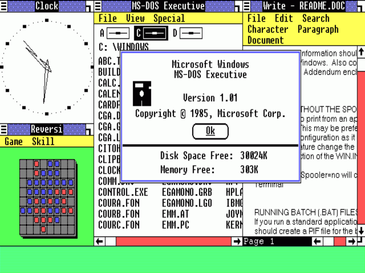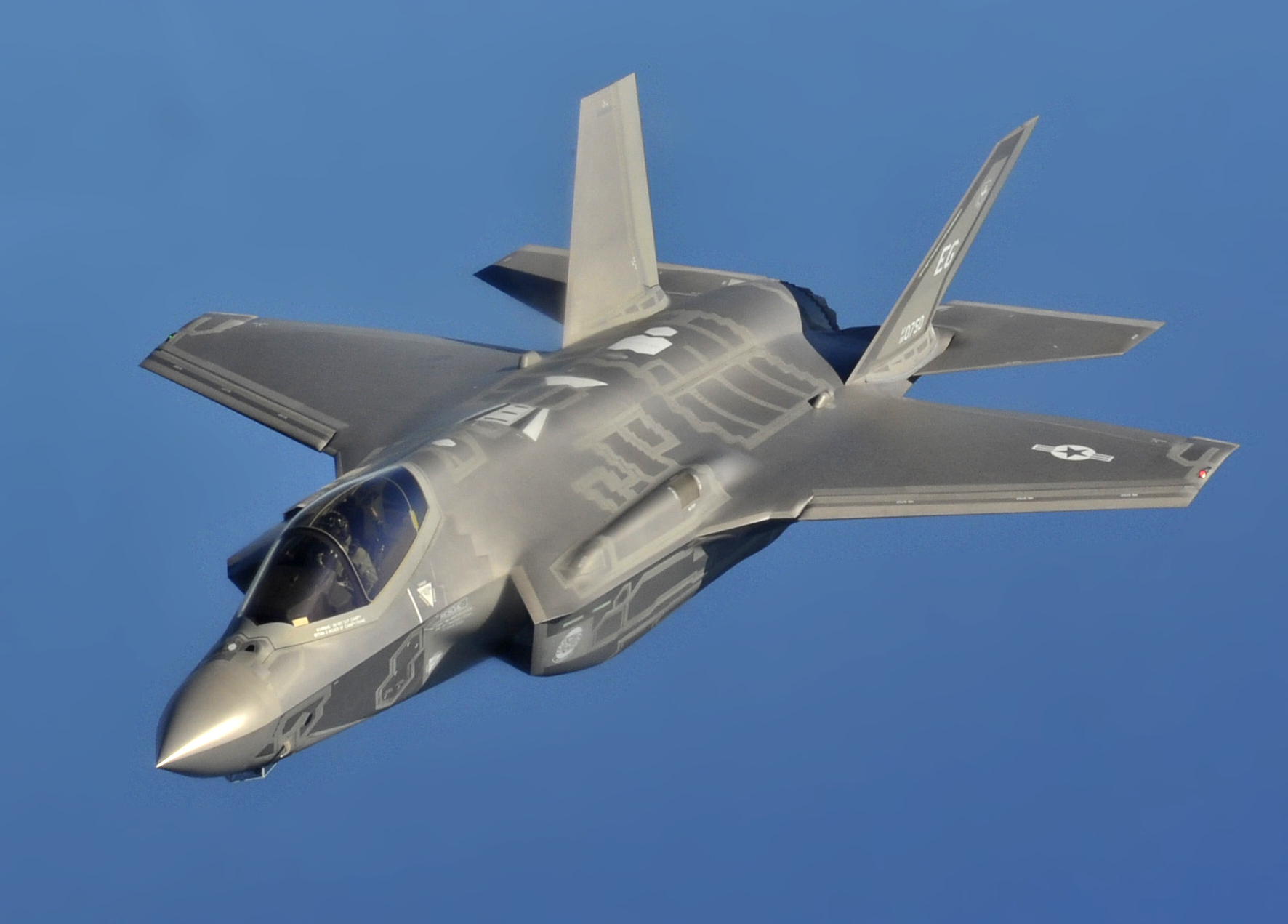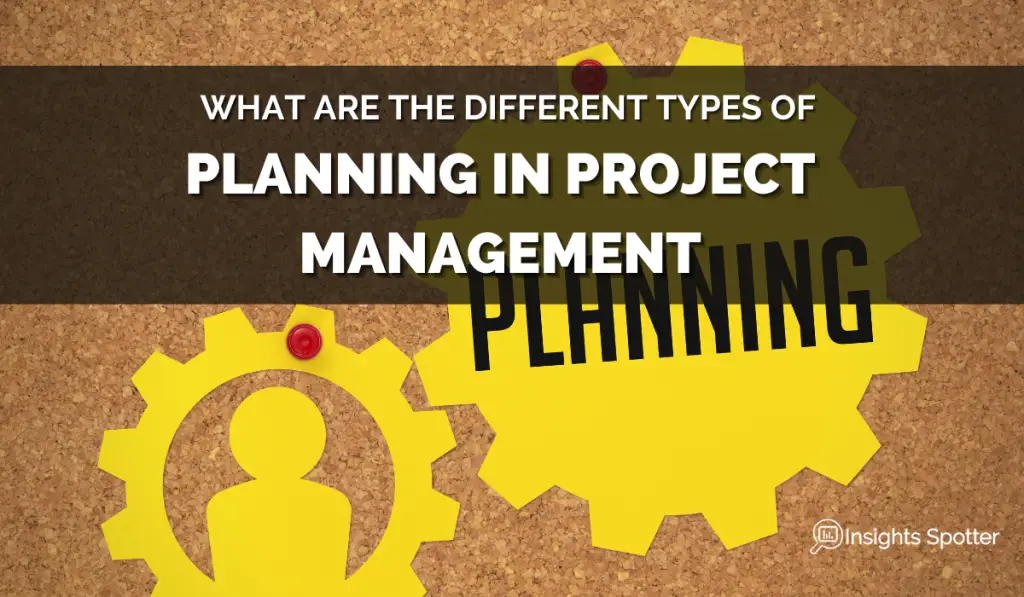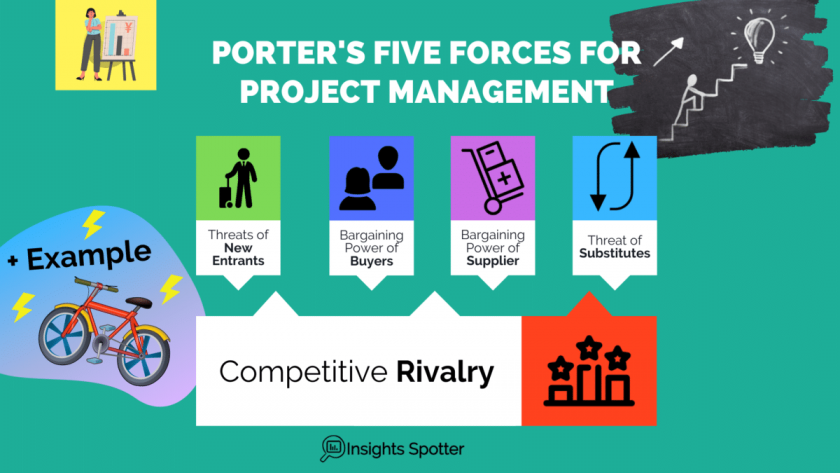How To Benefit From Porter’s Five Forces For Project Management?
At the highest level, the organisation will have a mission and objectives. To achieve goals, the organisation will develop strategies and projects to implement them. Poter’s Five-Forces help to systematically understand external competitive factors and adjust your programmes and projects accordingly.
Poter’s Five-Forces helps project managers in the planning and initiation stages of the project. The manager will create a plan, define objectives and align with the business’s strategy and goals. The framework helps to consider the external project and business environment’s opportunities and threats.
Understanding where Five-Forces fit in the project lifecycle is a good start, but if we want to use it in project management, it would be helpful to dive a bit deeper.
In the post, we will learn the way Porter’s Five Forces help project management. Then I will go through each force in the industry and describe what it means. After each description, we will consider real-world examples to make it more interesting.
Finally, we will look into the fictional case study for an electric bike company named “Two Wheels”. I will use Five-Forces to consider opportunities and threats, and I will identify the impacts it will have on the project. I hope you will enjoy it!
How Does Porter’s Five Forces Help Project Management?
Sometimes on the projects, you get to think about business strategy and objectives, and I find it particularly interesting. Usually, an organisation centres the strategy on the business environment and goals. When the ground that they operate shifts, they adjust the strategy. You will be glad to know that there are multiple tools you can use to identify the current business situation, like a position in the market, customer base and many more. Poter’s Five-Forces is one of those tools.
The framework helps businesses to create strategies supported by the evaluation of the competitive environment. And to implement strategy a programme or a project will be created. Then, the project manager can use Five-Forces to consider three angles:
-
Tangible & Intangible benefits & costs: project contribution to company’s profitability, revenues or expenses; knowing the competitive environment allows evaluating the attractiveness of specific solution or product, and what would it cost to compete in the market.
-
External Analysis: Five-Forces can be used together with PESTLE Analysis to understand most of the external opportunities and threats both for the project and organisation. Therefore, using opportunities to increase project success and threats to address risks. Check out my previous blog on PESTLE as well.
-
Impact of project success, i.e. achieved project’s objectives: looking through the additional lense of competitive advantage allows the project manager to evaluate the project’s options and goals comprehensively.
Now, Let’s understand what part of Porter’s Five-Forces is.
What are Porter’s Five Forces, summary?
The theory was born in Michael Porter’s head, who is a professor at Harvard Business School. He presented the theory in his book The Competitive Strategy. And of course, if you would like to learn more, do read the book. The approach looks into five vital competitive factors in the industry and points to potential external opportunities or threats.
What Do Poter’s Five Forces consider?
- Threats of new entrants
- Bargaining power of buyers
- The threat of substitutes products/services
- Bargaining power of supplier
- Competitive Rivalry
Porter believes that these Five-Forces are the most stable influencers of the industry. Thus, they should not be mistaken for more dynamic; these are distracting influencers like change in the interest rate, government monetary policy or new technology. It would be best if you built your business strategy on more stable grounds.
1. What Is Competitive Rivalry In Porter’s Five Forces?
Questions To Ask: Competitive Rivalry
- Are barriers to exit high?
- Are market growth rates low?
- Are there high or low product/services diversification, which could create price wars?
- Do market players have similar strategies?
- Are players similar in size?
- Are there a lot of players?
What Is Competitive Rivalry Definition In Porter’s Five Forces?
Each industry can have any number of competitors. However, not all of them have the same quality of goods or services. If you have done your market research, you should understand where your company sits on the scale.
 Suppose you found out that rivalry is intense, with many competitors or products with similar quality. In that case, the operating environment will be challenging with low margins and little funding for anything new like projects. Suppliers and buyers have many choices; if they do not get a good deal from you, they will not hesitate to go elsewhere. One great example is farming. Farmers has little to none influence to decide prices or who to sell produce.
Suppose you found out that rivalry is intense, with many competitors or products with similar quality. In that case, the operating environment will be challenging with low margins and little funding for anything new like projects. Suppliers and buyers have many choices; if they do not get a good deal from you, they will not hesitate to go elsewhere. One great example is farming. Farmers has little to none influence to decide prices or who to sell produce.
 On the other hand, where you have little to no competitive players, life can be more comfortable. You get good margins to have a lot of profits because you can charge high prices. One exciting example is the space flight industry. For some time, the most reliable and really available rockets were Russian once. However, they did not address threats in the industry and did not innovate. There were no considerable strategy shifts, new objectives or initiated new projects to remain near-monopoly. A small US company named SpaceX managed to catch up, increase competitive rivalry and start eroding profits for the Russian programme in just ten years, which is nothing in terms of the space industry.
On the other hand, where you have little to no competitive players, life can be more comfortable. You get good margins to have a lot of profits because you can charge high prices. One exciting example is the space flight industry. For some time, the most reliable and really available rockets were Russian once. However, they did not address threats in the industry and did not innovate. There were no considerable strategy shifts, new objectives or initiated new projects to remain near-monopoly. A small US company named SpaceX managed to catch up, increase competitive rivalry and start eroding profits for the Russian programme in just ten years, which is nothing in terms of the space industry.
2. What Is The Threats Of New Entrants In Porter’s Five Forces?
Questions To Ask: Threats Of New Entrants
- Do businesses need significant economies of scale to succeed in the industry?
- Are there legislation considerations or government acts that are difficult to implement for a new organisation?
- Are there high provider switching cost for customers?
- Do existing companies have strong customer relationships?
- Can a new entrant easily access the incumbents’ distribution channels?
- Can a new entrant easily access raw materials for production?
- Is there a supply issue for some essential materials, which incumbents control?
- Are there intellectual property patent protections that prevent from creating a similar product?
- Is there a strong brand loyalty for existing players?
- Are there any cost benefits that existing players have and a new entrant may not have immediately?
- Do business need massive initial capital spending, and you need to invest a lot upfront in starting?
What Is The Threats Of New Entrants Definition In Porter’s Five Forces?
The competition in the market is affected by the number of players, which is a dynamic number. Therefore, you need to consider the barriers to enter, i.e. how easy or hard for somebody to start the same or similar business. Hence, you will need to consider if you have some unique patents, how much equipment or technology costs; Are there any regulations that increase compliance costs, how strong is your brand.
 Suppose your industry barriers are low. In that case, you likely do not own any patents that prevent others from having an identical product, crucial technology is easy to replicate, and you do not need much money. Indeed, you can expect an increase in competition shortly. One interesting example is dropshipping; such a business model has almost no entry barriers as they do not own product stock and only facilitate transactions and promote products. You just need to pay for a generic site and spend some money on ads. The result?! You guessed it right; the profit margins are meagre now in the industry.
Suppose your industry barriers are low. In that case, you likely do not own any patents that prevent others from having an identical product, crucial technology is easy to replicate, and you do not need much money. Indeed, you can expect an increase in competition shortly. One interesting example is dropshipping; such a business model has almost no entry barriers as they do not own product stock and only facilitate transactions and promote products. You just need to pay for a generic site and spend some money on ads. The result?! You guessed it right; the profit margins are meagre now in the industry.
If barriers are high, your patents and technology are challenging to replicate, then the story is different, and competition for your business is lower.
 Though high barriers are not a constant state, say take Microsoft, who has released Microsoft Windows in November 1985. They have maintained a leading position until today. To create that good of the system is extraordinarily hard and takes a lot of smart people. However, not even Microsoft could sit still and stop improving (refer to a picture to see how the first version looked). So, they kept the barrier high by improving technology to maintain a competitive advantage. Bill Gates famously obsessed with potential and not existent competition even on the best of times. Have a read all about it in “Great by Choice: Uncertainty, Chaos and Luck – Why Some Thrive Despite Them All” by Morten T Hansen and Jim Collins.
Though high barriers are not a constant state, say take Microsoft, who has released Microsoft Windows in November 1985. They have maintained a leading position until today. To create that good of the system is extraordinarily hard and takes a lot of smart people. However, not even Microsoft could sit still and stop improving (refer to a picture to see how the first version looked). So, they kept the barrier high by improving technology to maintain a competitive advantage. Bill Gates famously obsessed with potential and not existent competition even on the best of times. Have a read all about it in “Great by Choice: Uncertainty, Chaos and Luck – Why Some Thrive Despite Them All” by Morten T Hansen and Jim Collins.
3. What Is Bargaining Power Of Buyers In Porter’s Five Forces?
Questions To Ask: Bargaining Power Of Buyers
- Does the customer well informed about a fair product price?
- Is the product essential to the customer?
- Can the customer manufacture the product?
- Will customer stope buy a product if the price goes up?
- Is it difficult and costly to switch providers?
- Are there substitutes in the market?
- Do suppliers to the businesses, who produce products to the customer, are few and have fixed cost?
- Does the customer buy only wholesale?
What Is Bargaining Power Of Buyers Definition in Porter’s Five Forces?
All profit-driven businesses need clients, which you can charge for goods and services. Thus, depending on how powerful or weak these buyers are will directly impact how much you can ask customers.
 If they can switch from one provider to the next one with ease or do not have many customers, your negotiating position would be weak. Again, the example could be farmers’ and supermarkets’ relationship. The farmer can only ask what the supermarket is willing to pay.
If they can switch from one provider to the next one with ease or do not have many customers, your negotiating position would be weak. Again, the example could be farmers’ and supermarkets’ relationship. The farmer can only ask what the supermarket is willing to pay.
 However, if you can lock in customer with contracts, create a high cost for switching providers, or maybe your product is essential to the customer, you have a lot of power. E.g. Would be, phone companies with 24 months contracts or drug companies like Pfizer, who have some essential medicine people will buy even if the prices go higher.
However, if you can lock in customer with contracts, create a high cost for switching providers, or maybe your product is essential to the customer, you have a lot of power. E.g. Would be, phone companies with 24 months contracts or drug companies like Pfizer, who have some essential medicine people will buy even if the prices go higher.
4. What Is Bargaining Power Of Supplier In Porter’s Five Forces?
Questions To Ask: Bargaining Power Of Supplier
- Are the suppliers to the market can easily integrate forward and become players in the market?
- Is it challenging to change supplier?
- Is the supplier-customer base fragmented?
- Are there a few suppliers available?
What Is Bargaining Power Of Supplier Definition In Porter’s Five Forces?
Similar to the bargaining power of buyers, we have the bargaining power of suppliers. We are considering here the characteristics and the number of available supplies for our business.
Of course, we want to get the best value for money. Still, it might not be on the cards. If there are only a few large suppliers, and your business highly depends on them, the competitive environment will be more challenging. Therefore, you will not be able to negotiate a reasonable price.
 Say, we take F-35s new fighter jets, produced by global effort and sold to multiple countries. One of the leading contractors is Lockheed Martin. The cost of one jet is $115 million, and very few other contractors can offer them. Thus, several governments have no choice but to pay the price for jets from Lockheed Martin if they want to be on top of the military game.
Say, we take F-35s new fighter jets, produced by global effort and sold to multiple countries. One of the leading contractors is Lockheed Martin. The cost of one jet is $115 million, and very few other contractors can offer them. Thus, several governments have no choice but to pay the price for jets from Lockheed Martin if they want to be on top of the military game.
 If you have many smaller suppliers, where you have a choice, you can drive their price down. For instance, let’s retake a supermarket example. If you look from their perspective, farmers are suppliers, and they all sell identical goods. Thus, a supermarket has a vast bargaining power to drive the price down.
If you have many smaller suppliers, where you have a choice, you can drive their price down. For instance, let’s retake a supermarket example. If you look from their perspective, farmers are suppliers, and they all sell identical goods. Thus, a supermarket has a vast bargaining power to drive the price down.
5. What Is The Threat Of Substitutes In Porter’s Five Forces?
Questions To Ask: The Threat Of Substitutes
- Is there challenging to switch to other providers?
- Are there a tendency to follow trends in the market?
- Is customers’ loyalty high for the existing brands in the market?
What Is The Threat Of Substitutes Definition In Porter’s Five Forces?
Here we are talking about customers finding other ways to accomplish what you offer. Is the service unique & challenging to replicate, or generic & straightforward? The answer to the question will have a significant impact on the outcome of available substitutes?
If there are many available substitutes for a client, the bargaining power of a company is diminished. Suppose your company offers expensive software as a service (SaaS) that solves the critical business problem; then, at some point, the business may decide to invest extra money to develop an internal version because it may be cheaper in the long term. Otherwise, the company may outsource the specific function to a third party.
 One example of outsourced services is in the logistics industry. There are hundreds of logistics companies in Europe, who own multiple trucks. However, most of the services are the same, to move goods from location “A” to location “B”. The business can choose any logistics company they like to move their products, and if no good value option is available, the company can even buy their truck.
One example of outsourced services is in the logistics industry. There are hundreds of logistics companies in Europe, who own multiple trucks. However, most of the services are the same, to move goods from location “A” to location “B”. The business can choose any logistics company they like to move their products, and if no good value option is available, the company can even buy their truck.
 If there are few alternatives, or it is challenging to replicate service, companies’ positions are much more complicated. Suppose we come back to SpaceX example. It is tough to build a new rocket. So, if you are a telecommunication company and you need your large satellite in space, you will have to buy the service of SpaceX and pay $62+ million. Thus, SpaceX position is excellent.
If there are few alternatives, or it is challenging to replicate service, companies’ positions are much more complicated. Suppose we come back to SpaceX example. It is tough to build a new rocket. So, if you are a telecommunication company and you need your large satellite in space, you will have to buy the service of SpaceX and pay $62+ million. Thus, SpaceX position is excellent.
6. What Are Compliments In Porter’s Six Forces?
Questions To Ask: Compliments
- Are there a lot of compliments available for the product in the market?
- Do rivals in the industry produce compliments?
- Can new entrant access bundle agreements with compliment producers?
What Is Compliments Definition In Porter’s Six Forces?
Although not part of the original Porter’s Five-Forces, compliments is a critical consideration as well. It considers the interrelationship between two goods that complement each other, and the customer gets more value when using both.
 For example, let’s take Apple’s iPhone and iTunes. The phone is excellent; it does what it suppose to do, i.e. calling. But when you combine with iTunes and the app store, you expand phones capabilities to sync music between devices or buy new apps like the weather app.
For example, let’s take Apple’s iPhone and iTunes. The phone is excellent; it does what it suppose to do, i.e. calling. But when you combine with iTunes and the app store, you expand phones capabilities to sync music between devices or buy new apps like the weather app.
Now, let’s look at our case study and apply all we have learned so far.
The Case Study: Two Wheels – e-Bike
The company we are going to look into is by the name Two Wheels (totally fictional). It is operating in the recreational and city bicycle market segment. Plus, the company is trying to position itself as a lifestyle brand. Though recently, Two Wheels has created a new objective to enter the e-bike market. The goal is to take 11% of the city and recreational bike market share in the EU by 2021. Thus, presently, it is looking to build a new electric bike. For that, they have initiated a project. The company decided to create an objective, plus linked strategies and embed these to the new project goals, and we can use Porter’s Five-Forces to help them out.
1. Two Wheels: Competitive Rivalry
Around ten well-known bicycle manufacturers are developing or already developed electric bikes capabilities for cities (fictional number). Thus, there is definitely some competition. Yet, the company still stands a chance to introduce a new product given that it has been manufacturing bicycles for many years now and have a loyal customer base.
Strategy Consideration: Competitive Rivalry
The business wants to find a competitive edge as part of its objective to compete with ten rivals. The firm has noticed that most competitors are taking the middle segment of the market, which is in a medium price range. Two Wheels would have to compete with these providers on price, which is, usually, not a good outcome for profit margins. Therefore, there are only two options:
- It can decide to produce lower specification bicycles with a lower price tag.
- Or higher-spec but more expensive once.
Project Impact: Competitive Rivalry
The company decided to go for high-specs and higher price segment and make a premium brand. The model will have top of the range parts and a unique aerodynamic frame with space for a basket to put your items. The Project Manager will need to include these in the project’s scope and evaluate the required parts and costs.
2. Two Wheels: Threats of new entrants
From the perspective of Two Wheels company, we are the new entry to the market. Thus, we need to prepare a project for a successful way to get in. The company has a great brand. It has an excellent reputation and reliable technology when it comes to mechanical bicycles.
Strategy Consideration: Threats of new entrants
However, they are coming into a new market with established e-bike players. They have also decided to go for a premium market, which means the production cost will be higher. Plus, there are additional safety regulations in the EU when it comes to e-bikes. The good news is that most competitors use the same third party engine parts and battery suppliers. Therefore, technology will not be an issue.
 Also, worth considering the Global E-Bike Market is projected to reach USD 38.6 billion by 2025 from an estimated USD 21.1 billion in 2018 based on MarketsandMarkets. Therefore, even if Two Wheels successfully introduces a new product, they need future prove their position. When you have such enormous growth in the industry, other business will try to enter the market and take a slice of the pie.
Also, worth considering the Global E-Bike Market is projected to reach USD 38.6 billion by 2025 from an estimated USD 21.1 billion in 2018 based on MarketsandMarkets. Therefore, even if Two Wheels successfully introduces a new product, they need future prove their position. When you have such enormous growth in the industry, other business will try to enter the market and take a slice of the pie.
Project Impact: Threats of new entrants
Our project manager will need to consider the high project cost to buy the required parts and address EU regulations. Also, we need to future proof the product. What will the manager have to do?
The testing phase may need to be increased to ensure the safety of the product. The business has not built e-bikes before, and many engineers are great at mechanical bikes but have little knowledge about electric parts. Thus, the project manager may need to upskill existing staff or hire new experts to increase quality. Furthermore, he/she will need to consider some additional software functionality features that would allow upgrading bicycles quickly in the future. Maybe introduce safety cameras to avoid collisions and wifi software update functionality. Thus, increasing technological barriers and discouraging new entrants with the same ideas.
3. Two Wheels: Bargaining Power of Buyers
Two Wheels company has many happy and loyal customers. However, none are currently owning an e-bike. Also, there are already ten other providers in the market for e-bike products. Hence, the situation in terms of buyers power is average at best.
Strategy Consideration: Bargaining Power of Buyers
The company can use the current customer base to release a new product. However, it needs to show how the new e-bike fits with young city professionals’ lifestyle or recreational users outside of the city.
Project Impact: Bargaining Power of Buyers
The Project Manager may want to consider including a social media marketing campaign as part of the product release. The campaign would show how the new bike goes well with the city lifestyle; thus, increasing significance to the existing customer base and decreasing customer bargaining power as they will want a new e-bike from the Two Wheels company.
4. Two Wheels: Bargaining Power of Suppliers
Our company manufactures most of the parts for a bicycle but will need to get a battery supplied from a third party.
Strategy Consideration: Bargaining Power of Suppliers
As most competitors use external battery providers, who all produce excellent performance, the company decides not to create battery internally and look for them outside. Let’s assume there are five options in the market for high-end e-bikes. Thus, suppliers do not hold very high power, and Two Wheels can choose either of them.
Project Impact: Bargaining Power of Suppliers
The project team will need to do market research to find the best battery supplier for a new e-bike. The project manager will need to allocate the time required in the plan. At one point, the team will enlist the procurement processes and request suppliers to provide samples and prefered agreement terms. There will be multiple meetings and negotiations to acquire the best battery with the most favourable terms, and that also takes a lot of time. The knowledge gained by the team in the market research will help to evaluate the bargaining power of suppliers and create the best strategy to get the best price.
5. Two Wheels: The Threat Of Substitutes Products Or Services
City and recreational e-bikes have a strong substitute, an e-scooter. In the city, conditions are usually acceptable to use both. Two Wheels’ clients typically go to see friends travel to work or shops, where an e-scooter performs as well as an e-bile. Thus, it is a real threat to the e-bike market.
Strategy Consideration: The threat of substitutes products
The company could have a strategy to offer longer range e-Bike to compete with usually short distance e-scooter.
Project Impact: The threat of substitutes products
To meet the business strategy project will need to include additional Non-Functional requirements to improve customer experience and mitigate the risk of customer substituting to a scooter. One such Non-Functional requirement could be to extend the bike’s range to 100 miles / 160 km. Second, ensure that the bike has a basket to hold various items. Third, provide a phone charger as well. All these become additional selling points and removing the risk of substitution.
6. Two Wheels: Compliments
Our business wants to have some complimentary services to differentiate from other manufactures.
Strategy Consideration: Compliments
Therefore, Two Wheels decided to have a repair shop and even provide a 100% discount for one year for all new buyers to aid e-bike efforts.
Project Impact: Compliments
The project manager will need to make sure that the manufacturer’s repair shop can accommodate new e-bikes. Unfortunately, as before, we did not have great expertise in the business and equipment. Thus, the manager will need to hire new staff and ensure the right equipment is available as part of the project before the new e-bike release date.
Porter’s Five Forces In Project Management Conclusion
From the case study, you can see, when we have considered various forces in the industry, we have started to see multiple-elements the project manager needs to address in the plan and project constraints. Some examples are:
-
Increase in cost: additional staff and equipment
-
Increase in time: exploring battery suppliers
-
Quality assurance: reduce the effect of e-scooters substitution
-
Increase in scope: the establishment of the manufacture repair shop.
Suppose we did not do Porter’s Five-Forces analysis. In that case, our manager may not have considered some influences and could have had issues in the future, like an unexpected increase in the scope of budgets. Now though, we are ready to move forward.
Thus, the model helps with a well-organised, ordered and structured analysis of the operating market and competitive environment. Porter’s Five-Forces model can be used to evaluate companies, regions, countries and, of course, projects.
In conclusion, you should complete the analysis in the project’s initiation and planning stages to increase project success by aligning the project with business strategy and objectives. Let me know in the comments below how you would use Porter’s Five-Forces model in your project.
Subscribe to our newsletter!
Latest Blog Posts
- Sustainable Project Management: Trends, Tools, & Strategies
- Unlocking Strategic Value: How NIST CSF 2.0 Shapes Project Choices for Better Outcomes
- Cybersecurity Project Management: Protecting Your Digital Frontier
- What are the Different Types of Planning in Project Management?

- Transforming Project Management with AI Software: Tools, Challenges, and Best Practices
- Unlocking the Benefits of AI-Powered Project Management

